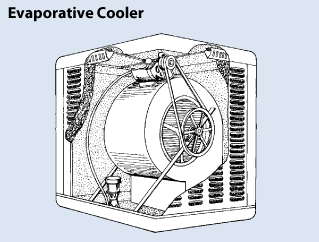Evaporative cooling uses evaporated water to naturally and energy-efficiently cool.
 |
| In this example of an evaporative cooler, a small motor (top) drives a large fan (center) which blows air out the bottom and into your home. The fan sucks air in through the louvers around the box, which are covered with water-saturated absorbent material. |
How Evaporative Coolers Work
There are two types of evaporative coolers: direct and indirect.
Direct evaporative coolers, also called swamp coolers, work by cooling outdoor air by passing it over water-saturated pads, causing the water to evaporate into it. The 15°-40°F-cooler air is then directed into the home or building and pushes warmer air out through windows. Direct evaporative cooling systems are often roof mounted when used in commercial buildings.
When operating a direct evaporative cooler, windows or vents are opened part way to allow warm indoor air to escape as it's replaced by cooled air. Unlike central air conditioning systems that recirculate the same air, evaporative coolers provide a steady stream of fresh air into the building.
Indirect evaporative coolers have a heat exchanger that prevents humidity from entering the building. Efficiency tends to be lower than that of direct evaporative coolers.
Evaporative coolers require more frequent maintenance than refrigerated air conditioners and are suitable only for areas with low humidity.
Evaporative Cooling in Commercial Buildings
On larger buildings in hot, dry climates, the benefits of evaporative cooling can be achieved through roof-spray technology. A modified spray-irrigation system can be used on the roof to drop daytime roof-surface temperatures from. With a typical (poorly insulated) roof system, this can reduce interior temperatures significantly.
Another type of evaporative cooling for commercial buildings is night-sky radiant cooling. This approach works in climates with large diurnal temperature swings and clear nights (such as in the Southwest). Water is sprayed onto a low-slope roof surface at night and cooled through a combination of evaporation and radiation. The water drains to a tank in the basement or circulates through tubing embedded in a concrete floor slab. Daytime cooling is accomplished either by circulating cooled water from the tank or through passive means from the concrete slab.
More Information
Visit the Energy Saver website for more information about the sizing, selection, installation, operation, and maintenance of evaporative coolers in homes.

